Engineers Changing the World: Education for Sustainability in Romanian Technical Universities—An Empirical Web-Based Content Analysis
Abstract
1. Introduction
2. Background on Sustainable Development & Sustainability in Engineering Education
2.1. Origins of Sustainable Development
2.2. Education for Sustainable Development (ESD) and Sustainability in Engineering Education
- To develop dedicated sustainable engineering courses (48%)
- To integrate sustainable engineering concepts into traditional engineering courses with the goal of broadening students’ awareness and skill set (23%)
- To deliver classes which focus on the technologies predicted to be important in developing sustainable engineering solutions (such as carbon capture or solar power) (14%)
- To work in conjunction with a non-engineering department and create a cross-listed or interdisciplinary course offering (e.g., economics, policy development, social psychology) (15%).
3. Materials and Methods
- How are technical universities integrating SD-related subjects into their curricula for bachelor and master programs?
- What are the most frequent sustainability-related subjects integrated into the curricula?
- What are the engineering programs that most frequently include sustainability concepts in the curricula?
- Polytechnic University of Bucharest (UPB)
- Technical University of Civil Engineering of Bucharest (UTCB)
- Technical University of Cluj Napoca (TUCN)
- Technical University “Gheorghe Asachi” Iasi (TUIASI)
- Polytechnic University of Timisoara (UPT)
4. Results and Discussions
- UPB most SD-related classes, taken together for both bachelor and master, are offered at the Faculty of Power Engineering (SD-related classes represent 13.36% of all bachelor classes and 31.11% of all master classes) (Figure 1). The next faculty to follow is the Faculty of Entrepreneurship, Business Engineering, and Management (SD-related classes represent 14.51% of all bachelor classes and 24.59% of all master classes), a faculty which is particular to UPB as generally the purely technical universities in Romania, even though they offer courses related to management and business, they do not usually have a separate school in the university. In comparison to the SD classes that we found at the Faculty of Power Engineering that are mostly related to Environment and Pollution, the Faculty of Entrepreneurship, Business Engineering and Management offer SD classes on Corporate Social Responsibility, Market Economy, Human rights, Entrepreneurship, Communication or Fair trade. In terms of the general strategy of the University, there is only one reference to sustainability, related with social responsibility in the Strategic Plan of Institutional Development.
- UTCB most SD related classes, taken together for both bachelor and master, are offered at the Faculty of Hydrotechnics (14.87% SD classes from total class offering, where SD-related classes represent 13.06% of all bachelor classes and 20.37% of all master classes) followed by the Faculty of Engineering Installations (SD related classes represent 7.36% of all bachelor classes and 15.38% of all master classes) (Figure 2). This result can be explained by the fact that the Faculty of Hydrotechnics offers at the bachelor level the specializations “Environmental engineering” and “Sanitary engineering and environmental protection” and at the master level a specialization directly targeting sustainable development, named exactly like that. The Faculty of Engineering Installations, on the other hand, offers the specializations “Appliances and equipment for atmospheric protection” at the bachelor level and “Competitive technologies for urban environment protection” and “Energy, comfort and sustainable development” at the master level. There are no references to sustainability and SD in the university’s strategic plan for 2016–2020.
- TUCN most SD related classes, taken together for both bachelor and master, are offered at the Faculty of Materials and Environmental Engineering (SD related classes represent 13.85% of all bachelor classes and 33.15% of all master classes) with a percentage of SD classes of 19.27%, which is due to the fact that it has a specialization at the master level entirely dedicated to sustainable development, called Engineering, The Right, and the Economy of Sustainable Development (Figure 3). Next faculty in line is the Faculty of Engineering Baia Mare (13.41% SD classes from total class offerings, where 11.04% of all bachelor classes and 25.53% of all master classes are SD classes). This faculty offers, at the bachelor level, a specialization called Engineering and Environmental Protection in Industry, and at the master level, a specialization called Environmental Impact and Risk Assessment, were most of SD classes are taught. In terms of the general strategy of the university, the 2016–2020 strategic plan has references to financial sustainability and sustainable development, the latter being connected with the idea of reshaping the educational process to better respond to the real needs of the socio-economic environment.
- TUIASI most SD-related classes, taken together for both bachelor and master, are offered at the Faculty of Hydrotechnics, Geodesy, and Environmental Engineering (15%—SD-related classes represent 13.71% of all bachelor classes and 18.69% of all master classes), closely followed by the Faculty of Chemical Engineering and Environmental Protection with 13% SD classes (SD-related classes represent 6.37% of all bachelor classes and 53.23% of all master classes) (Figure 4). This number is higher than all others registered due to the fact that both faculties have Master programs in Environmental Management, Environmental Management and Sustainable Energy and Waste Management, Treatment and Recovery. At the same time, at TUIASI 17, courses had entrepreneurship in the title, most of the classes being included in the third and fourth year curricula, as a result of a university-wide project aiming at improving the entrepreneurial culture and competencies of the engineering students enrolled. In terms of the general strategy of the university, in the 2016–2020 strategic plan there is only one reference to financial sustainability and there is a list of objectives and strategies regarding environmental protection.
- UPT most SD-related classes, taken together for both bachelor and master, are offered at the Faculty of Industrial Chemistry and Environmental Engineering with a percentage of SD classes of approximately 23.41% from total class offerings (SD related classes represent 23.14% of all bachelor classes and 26.08% of all master classes) (Figure 5). This is somehow understandable as the name of the faculty indicates that there are a lot of specializations related to the environment, namely environmental protection. At a great distance from what constitutes SD class offerings follows the Faculty of Civil Engineering (9.67% SD classes from total class offerings), which offers a specialization at the bachelor level also related to environmental protection (SD-related classes represent 8.54% of all bachelor classes and 14.01% of all master classes). In terms of general strategy, the Polytechnic University of Timisoara (UPT) has the most detailed view on sustainability from all the analyzed universities. The university places sustainability as a necessity in contemporary context and it plans to find ways to reduce resource waste in all activities.
5. Conclusions and Implications
- The number of SD-related courses differs between universities and their faculties, with a minimum of one course and a maximum of 106 courses at the bachelor level and a minimum of one course and a maximum of 84 courses at the master level.
- 16.79% of the SD-related courses are being offered at the master level, while only 6.93% are offered at the bachelor level.
- There is also an important difference between the bachelor and master level SD class offerings, namely, at the bachelor level most of the SD-related courses are optional (54.45%), while at the master level, the majority of SD-related courses are mandatory (67.39%).
- Faculties which offer a greater number of SD classes have specializations, for both bachelor and master program, that are centered mainly on pollution, natural resources, recycling, reusing, ecology, ecosystem, and environment.
- One way to ensure systemic integration is through national centralized decision bodies, e.g., the ethics class included by all universities at the master level.
6. Limitations and Future Research
Author Contributions
Funding
Conflicts of Interest
References
- Wenz, L.; Levermann, A. Enhanced economic connectivity to foster heat stress-related losses. Science Advances 2016, 2, e1501026. [Google Scholar] [CrossRef] [PubMed]
- Disterheft, A.; Caeiro, S.; Azeiteiro, U.M.; Leal Filho, W. Sustainability Science and Education for Sustainable Development in Universities: A Way for Transition. In Sustainability Assessment Tools in Higher Education Institutions; Caeiro, S., Leal Filho, W., Jabbour, C., Azeiteiro, U.M., Eds.; Springer International Publishing: Cham, Switzerland, 2013; pp. 3–27. ISBN 978-3-319-02374-8. [Google Scholar]
- United Nations. World Commission on Environment and Development. Our Common Future (The Brundtland Report). 1987. Available online: https://sustainabledevelopment.un.org/content/documents/5987our-common-future.pdf (accessed on 27 November 2019).
- Council of the European Union. Renewed EU Sustainable Development Strategy (EU SDS). Brussels, 9 June 2006. Available online: https://register.consilium.europa.eu/doc/srv?l=EN&f=ST%2010117%202006%20INIT (accessed on 27 November 2019).
- European Commission. EUROPE 2020: A Strategy for Smart, Sustainable and Inclusive Growth, Communication from the Commission, Brussels, 3.3.2010. Available online: https://ec.europa.eu/eu2020/pdf/COMPLET%20EN%20BARROSO%20%20%20007%20-%20Europe%202020%20-%20EN%20version.pdf (accessed on 27 November 2019).
- Ramos, G.I. The Sustainable Development Goals: A duty and an opportunity. In Debate the Issues: New Approaches to Economic Challenges; Love, P., Ed.; OECD Publishing: Paris, France, 2016; pp. 17–21. [Google Scholar]
- Sibbel, A. Pathways towards sustainability through higher education. Int. J. Sustain. High. Educ. 2009, 10, 68–82. [Google Scholar] [CrossRef]
- Celikdemir, Z.D.; Gunay, G.; Katrinli, A.; Penbek Alpbaz, S. Defining sustainable universities following public opinion formation process. Int. J. Sustain. High. Educ. 2017, 18, 294–306. [Google Scholar] [CrossRef]
- UNESCO. United Nations Decade of Education for Sustainable Development (2005–2014): International Implementation Scheme. Paris, 2005. Available online: https://unesdoc.unesco.org/ark:/48223/pf0000139937 (accessed on 1 December 2019).
- UNESCO. Education and the Search for a Sustainable Future. Policy Dialogue 1: ESD and Development Policy. 2009. Available online: https://unesdoc.unesco.org/ark:/48223/pf0000179121 (accessed on 27 November 2019).
- Desha, C.J.; Hargroves, K.; Smith, M.H. Addressing the time lag dilemma in curriculum renewal towards engineering education for sustainable development. Int. J. Sustain. High. Educ. 2009, 10, 184–199. [Google Scholar] [CrossRef]
- UNESCO. Available online: http://www.unesco.org/new/en/natural-sciences/science-technology/engineering/sustainable-engineering/ (accessed on 27 November 2019).
- Dowling, D.; Carew, A.; Hadgraft, R. Engineering Your Future: An. Australasian Guide; John Wiley & Sons Australia, Ltd.: Brisbane, Australia, 2010; ISBN 9780470818169. [Google Scholar]
- Rosen, M. Engineering Sustainability: A Technical Approach to Sustainability. Sustainability 2012, 4, 2270–2292. [Google Scholar] [CrossRef]
- Lambrechts, W.; Mulà, I.; Ceulemans, K.; Molderez, I.; Gaeremynck, V. The integration of competences for sustainable development in higher education: An analysis of bachelor programs in management. J. Clean. Prod. 2013, 48, 65–73. [Google Scholar] [CrossRef]
- Sady, M.; Zak, A.; Rzepka, K. The role of universities in Sustainability- Oriented Competencies Development: Insights from an Empirical Study on Polish Universities. Adm. Sci. 2019, 9, 62. [Google Scholar] [CrossRef]
- García-Feijoo, M.; Eizaguirre, A.; Rica-Aspiunz, A. Systematic Review of Sustainable-Development-Goal Deployment in Business Schools. Sustainability 2020, 12, 440. [Google Scholar] [CrossRef]
- Byrne, E.; Desha, C.; Fitzpatrick, J.; Hargroves, H. Engineering Education for Sustainable Development: A Review of International Progress. In 3rd International Symposium for Engineering Education; University College Cork: Cork, Ireland, 2010. [Google Scholar]
- Davidson, C.I.; Hendrickson, C.T.; Matthews, H.S.; Bridges, M.W.; Allen, D.T.; Murphy, C.F.; Allenby, B.R.; Crittenden, J.C.; Austin, S. Preparing future engineers for challenges of the 21st century: Sustainable engineering. J. Clean. Prod. 2010, 18, 698–701. [Google Scholar] [CrossRef]
- Lozano, F.J.; Lozano, R. Developing the curriculum for a new bachelor’s degree in engineering for sustainable development. J. Clean. Prod. 2013, 64, 136–146. [Google Scholar] [CrossRef]
- Watson, M.K.; Lozano, R.; Noyes, C.; Rodgers, M. Assessing curricula contribution to sustainability more holistically: Experiences from the integration of curricula assessment and students’ perceptions at the Georgia institute of technology. J. Clean. Prod. 2013, 61, 106–116. [Google Scholar] [CrossRef]
- Colombo, C.R.; Alves, A.C. Sustainability in engineering programs in a Portuguese Public University. Production 2017, 27. [Google Scholar] [CrossRef]
- Quelhas, O.L.G.; Lima, G.B.A.; Ludolf, N.V.-E.; Meiriño, M.J.; Abreu, C.; Anholon, R.; Rodrigues, L.S.G. Engineering education and the development of competencies for sustainability. Int. J. Sustain. High. Educ. 2019, 20, 614–629. [Google Scholar] [CrossRef]
- Mesa, J.A.; Esparragoza, I.E.; Maury, H. Sustainability in engineering education: A literature review of case studies and projects. In Proceedings of the 15th LACCEI International Multi-Conference for Engineering, Education, and Technology, Boca Raton, FL, USA, 19–21 July 2017. [Google Scholar]
- Bergsmann, E.; Schultes, M.-T.; Winter, P.; Schober, B.; Spiel, C. Evaluation of competence-based teaching in higher education: From theory to practice. Eval. Program Plan. 2015, 52, 1–9. [Google Scholar] [CrossRef]
- Boccanfuso, D.; Larouche, A.; Trandafir, M. Quality of higher education and the labor market in developing countries: Evidence from an education reform in Senegal. World Dev. 2015, 74, 412–424. [Google Scholar] [CrossRef]
- Hussain, T.; Eskildsen, J.; Edgeman, R.; Ismail, M.; Shoukry, A.M.; Gani, S. Imperatives of Sustainable University Excellence: A Conceptual Framework. Sustainability 2019, 11, 5242. [Google Scholar] [CrossRef]
- Velazquez, L.; Munguia, N.; Sanchez, M. Deterring sustainability in higher education institutions. Int. J. Sustain. High. Educ. 2005, 6, 383–391. [Google Scholar] [CrossRef]
- Beynaghi, A.; Trencher, G.; Moztarzadeh, F.; Mozafari, M.; Maknoon, R.; Leal Filho, W. Future sustainability scenarios for universities: Moving beyond the United Nations Decade of Education for Sustainable Development. J. Clean. Prod. 2016, 112, 3464–3478. [Google Scholar] [CrossRef]
- Waas, T.; Verbruggen, A.; Wright, T. University research for sustainable development: Definition and characteristics explored. J. Clean. Prod. 2010, 18, 629–636. [Google Scholar] [CrossRef]
- Association of University Leaders for a Sustainable Future—The Talloires Declaration 10 Point Action Plan. Available online: http://ulsf.org/wp-content/uploads/2015/06/TD.pdf (accessed on 27 November 2019).
- Calder, W.; Clugston, R. International efforts to promote higher education for sustainable development. In Teaching Education for Sustainable Development at University Level, World Sustainability Series; Filho, W.L., Pace, P., Eds.; Springer International Publishing: Basel, Switzerland, 2016; pp. 162–174. [Google Scholar]
- Jones, P.; Selby, D.; Sterling, S. More than the Sum of their Parts? Interdisciplinarity and Sustainability. In Sustainability Education: Perspectives and Practice across Higher Education; Jones, P., Selby, S., Sterling, S., Eds.; Earthscan: London, UK, 2010; ISBN 1844078779. [Google Scholar]
- Velazquez, L.; Munguia, N.; Platt, A.; Taddei, J. Sustainable university: What can be the matter? J. Clean. Prod. 2006, 14, 810–819. [Google Scholar] [CrossRef]
- Adams, R.; Martin, S.; Boom, K. University Culture and Sustainability: Designing and Implementing an Enabling Framework. J. Clean. Prod. 2018, 171, 434–445. [Google Scholar] [CrossRef]
- Grecu, V.; Ipina, N. The Sustainable University—A Model for The Sustainable Organization. Manag. Sustain. Dev. Sibiu 2014, 6, 15–24. [Google Scholar] [CrossRef]
- United Nations. Education Commitments Agenda 21—Chapter 36 & UN Commission on Sustainable Development. 1992. Available online: https://www.iatp.org/sites/default/files/Education_Commitments_-_Agenda_21_Chapter_36.htm (accessed on 3 December 2019).
- UNESCO. Education for Sustainable Development Goals: Learning Objectives. 2017. Available online: https://unesdoc.unesco.org/ark:/48223/pf0000247444 (accessed on 4 December 2019).
- Maloney, W.F.; Caicedo, F.V. Engineering Growth: Innovative Capacity and Development in the Americas; World Bank Research Publication: Washington, DC, USA, 2017; Available online: http://pubdocs.worldbank.org/en/422491458852358129/Engineers-County7A.pdf (accessed on 23 December 2019).
- Azapagic, A.; Perdan, S.; Shallcross, D. How much do engineering students know about sustainable development? The findings of an international survey and possible implications for the engineering curriculum. Eur. J. Eng. Educ. 2005, 30, 1–19. [Google Scholar] [CrossRef]
- Sterling, S.; Thomas, I. Education for sustainability: The role of capabilities in guiding university curricula. Int. J. Innov. Sustain. Dev. 2006, 1, 349. [Google Scholar] [CrossRef]
- Riley, D.R.; Grommes, A.V.; Thatcher, C.E. Teaching sustainability in building design and engineering. J. Green Build. 2007, 2, 175–195. [Google Scholar] [CrossRef]
- Lozano, R. Diffusion of sustainable development in universities’ curricula: An empirical example from Cardiff University. J. Clean. Prod. 2010, 18, 637–644. [Google Scholar] [CrossRef]
- Boks, C.; Diehl, J.C. Integration of sustainability in regular courses: Experiences in industrial design engineering. J. Clean. Prod. 2006, 14, 932–939. [Google Scholar] [CrossRef]
- Abdul-Wahab, S.A.; Abdulraheem, M.Y.; Hutchinson, M. The need for inclusion of environmental education in undergraduate engineering curricula. Int. J. Sustain. High. Educ. 2003, 4, 126–137. [Google Scholar] [CrossRef]
- Kamp, L. Engineering education in sustainable development at Delft University of Technology. J. Clean. Prod. 2006, 14, 928–931. [Google Scholar] [CrossRef]
- Thomas, I. Sustainability in tertiary curricula: What is stopping it happening? Int. J. Sustain. High. Educ. 2004, 5, 33–47. [Google Scholar] [CrossRef]
- Mulder, K.F. Engineering curricula in sustainable development. An evaluation of changes at Delft University of Technology. Eur. J. Eng. Educ. 2006, 31, 133–144. [Google Scholar] [CrossRef]
- Huntzinger, D.N.; Hutchins, M.J.; Gierke, J.S.; Sutherland, J.W. Enabling sustainable thinking in undergraduate engineering education. Int. J. Eng. Educ. 2007, 23, 218–230. [Google Scholar]
- Tejedor, G.; Segalàs, J.; Rosas-Casals, M. Transdisciplinarity in higher education for sustainability: How discourses are approached in engineering education. J. Clean. Prod. 2018, 175, 29–37. [Google Scholar] [CrossRef]
- Sánchez-Carracedo, F.; Moreno-Pino, F.M.; Sureda, B.; Antúnez, M.; Gütierrez, I. A Methodology to Analyze the Presence of Sustainability in Engineering Curricula. Case of Study: Ten Spanish Engineering Degree Curricula. Sustainability 2019, 11, 4553. [Google Scholar] [CrossRef]
- Allen, D.; Allenby, B.; Bridges, M.; Crittenden, J.; Davidson, C.; Hendrickson, C.; Matthews, C.; Murphy, C.; Pijawka, D. Benchmarking Sustainability Engineering Education: Final Report; Centre for Sustainable Engineering: Pittsburgh, PA, USA, 2008. [Google Scholar]
- Byrne, E.P.; Desha, C.J.; Fitzpatrick, J.J.; “Charlie” Hargroves, K. Exploring sustainability themes in engineering accreditation and curricula. Int. J. Sustain. High. Educ. 2013, 14, 384–403. [Google Scholar] [CrossRef]
- Pappas, E.; Pappas, J. A behavioral approach to building cognitive foundations for effective thought and action. Innov. High. Educ. 2011, 36, 359–372. [Google Scholar] [CrossRef]
- Allenby, B.; Folsom Murphy, C.; Allen, D.; Davidson, C. Sustainable engineering education in the United States. Sustain. Sci. 2009, 4, 7. [Google Scholar] [CrossRef]
- Bjornberg, K.E.; Skogh, I. Integrating social sustainability in engineering education at the KTH royal institute of technology. Int. J. Sustain. High. Educ. 2015, 16, 639–649. [Google Scholar] [CrossRef]
- Christ, J.A.; Heiderscheidt, J.L.; Pickenpaugh, M.Y.; Phelan, T.J.; Pocock, J.B.; Stanford, M.S.; Twesme, T.M. Incorporating Sustainability and Green Engineering into a Constrained Civil Engineering Curriculum. J. Prof. Issues Eng. Educ. Prat. 2015, 141. [Google Scholar] [CrossRef]
- Rose, G.; Ryan, K.; Desha, C. Implementing a holistic process for embedding sustainability: A case study in first year engineering, Monash University, Australia. J. Clean. Prod. 2015, 106, 229–238. [Google Scholar] [CrossRef]
- Romanian Ministry of Education. Report regarding the Higher Education Status in Romania 2017–2018. Available online: https://www.edu.ro/sites/default/files/Raport%20privind%20starea%20%C3%AEnv%C4%83%C8%9B%C4%83m%C3%A2ntului%20superior%20din%20Rom%C3%A2nia_%202017%20-2018.pdf (accessed on 4 December 2019).
- Wu, Y.-C.J.; Huang, S.; Kuo, L.; Wu, W.-H. Management Education for Sustainability: A Web-Based Content Analysis. Acad. Manag. Learn. Educ. 2010, 9, 520–531. [Google Scholar] [CrossRef]
- Mulder, K. Engineering education in sustainable development: Sustainability as a tool to open up the windows of engineering institutions. Bus. Strateg. Environ. 2004, 13, 275–285. [Google Scholar] [CrossRef]
- Khan, T. Sustainability accounting courses, Talloires Declaration and academic research. Int. J. Sustain. High. Educ. 2013, 14, 42–55. [Google Scholar] [CrossRef]
- Mustaţă, R.V.; Bonaci, C.G.; Hintea, C.; Neamţu, B. Business education for sustainable development: The case of Romanian universities. Amfiteatru Econ. J. 2013, 15, 802–818. [Google Scholar]
- O’Byrne, D.; Dripps, W.; Nicholas, K.A. Teaching and learning sustainability: An assessment of the curriculum content and structure of sustainability degree programs in higher education. Sustain. Sci. 2015, 10, 43–59. [Google Scholar] [CrossRef]
- Power, C. The Power of Education: Education for All, Development, Globalisation and UNESCO; Springer: London, UK, 2015. [Google Scholar]
- Lozano, R. Incorporation and institutionalization of SD into universities: Breaking through barriers to change. J. Clean. Prod. 2006, 14, 787–796. [Google Scholar] [CrossRef]
- Hopwood, B.; Mellor, M.; O’Brien, G. Sustainable development: Mapping different approaches. Sustain. Dev. 2005, 13, 38–52. [Google Scholar] [CrossRef]
- Bruyat, C.; Pierre-Andre, J. Defining the field of research in entrepreneurship. J. Bus. Ventur. 2001, 16, 165–180. [Google Scholar] [CrossRef]
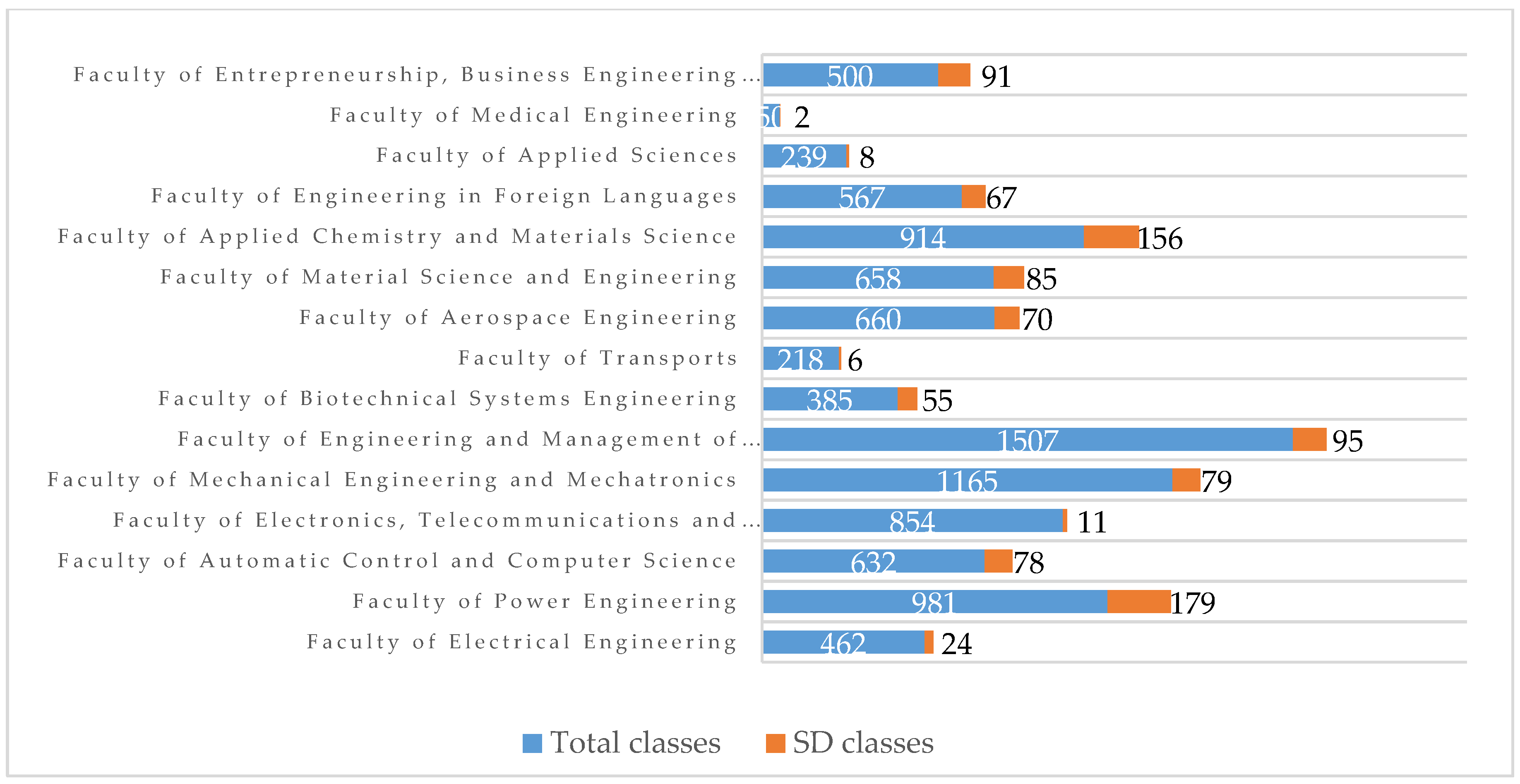
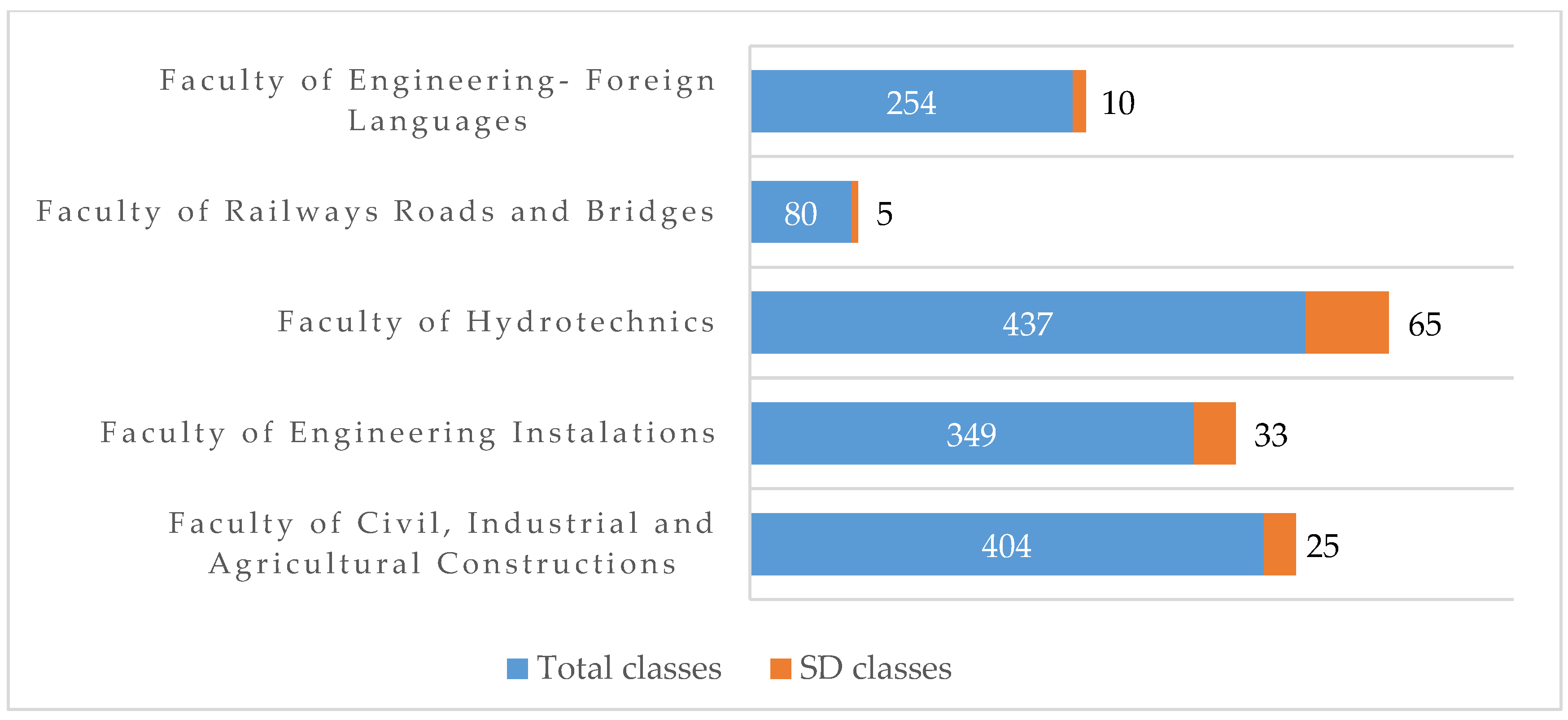

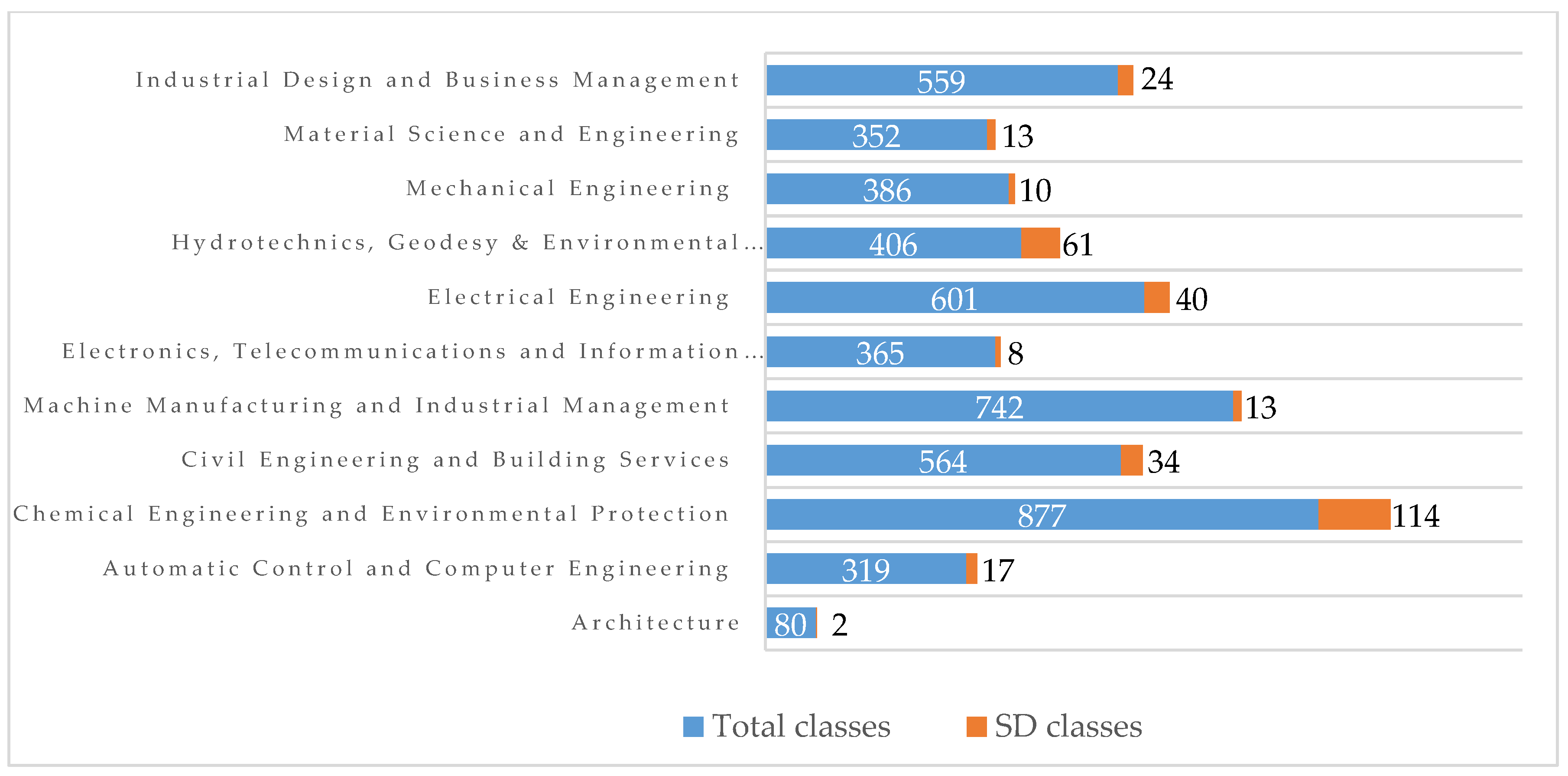
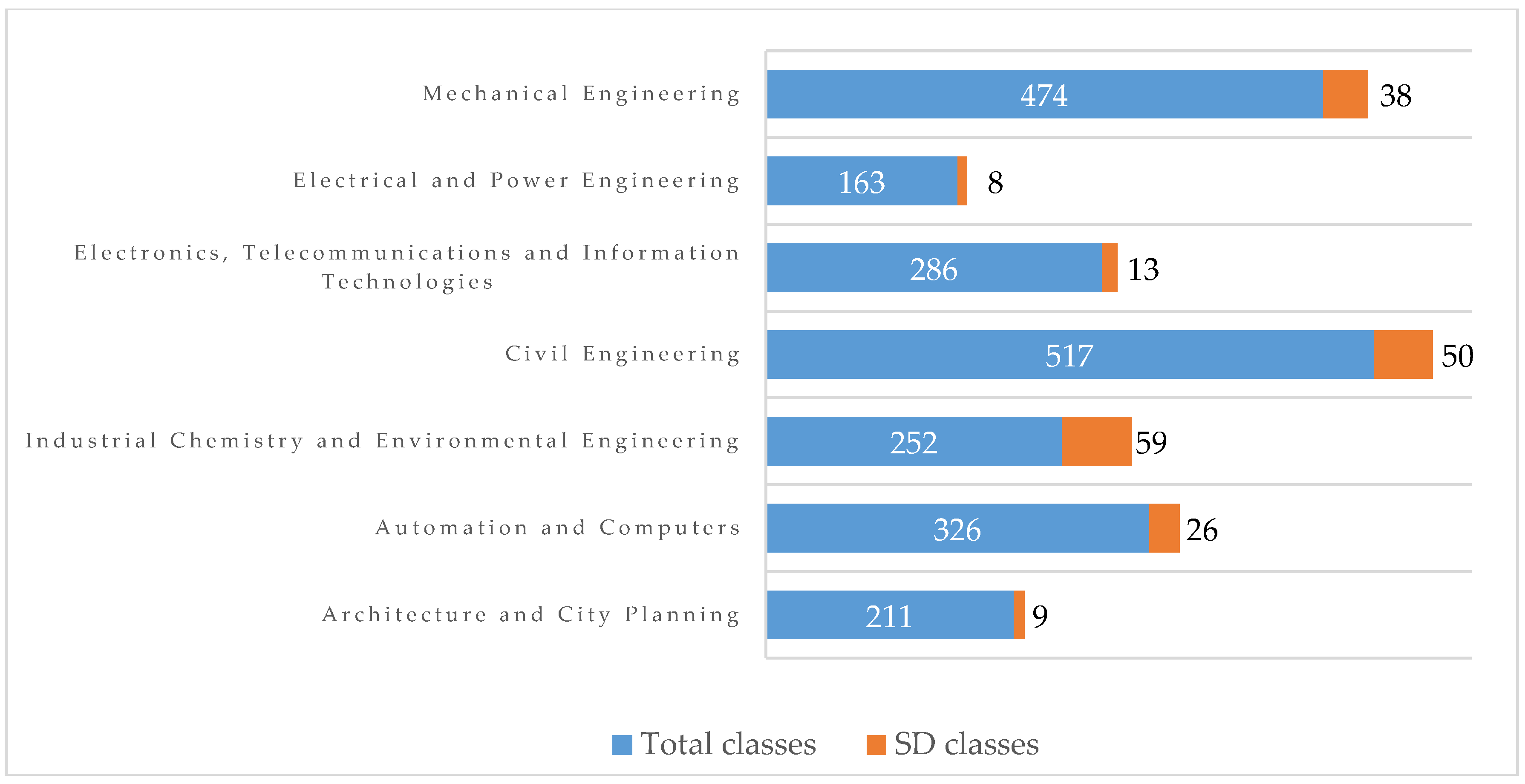
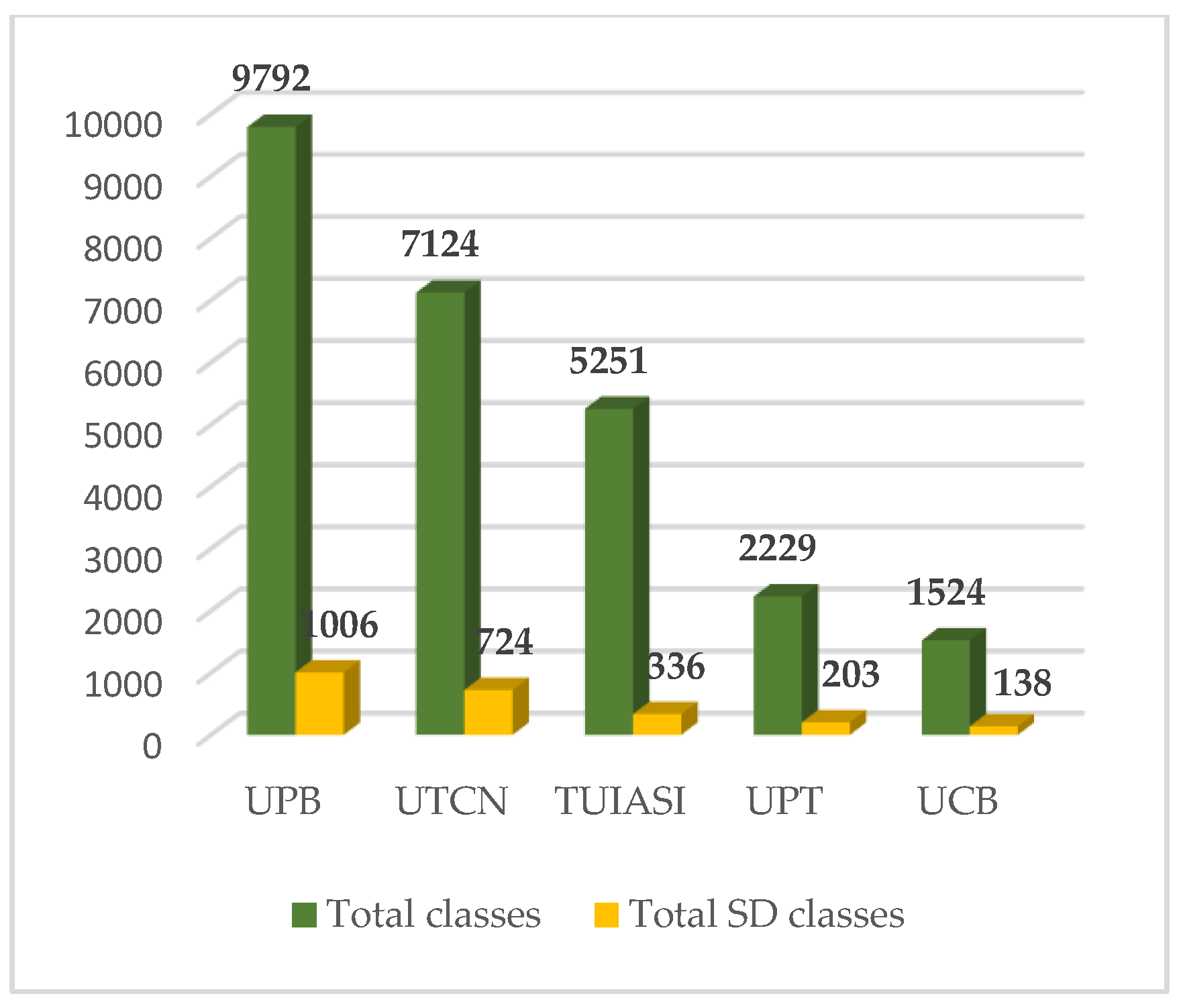
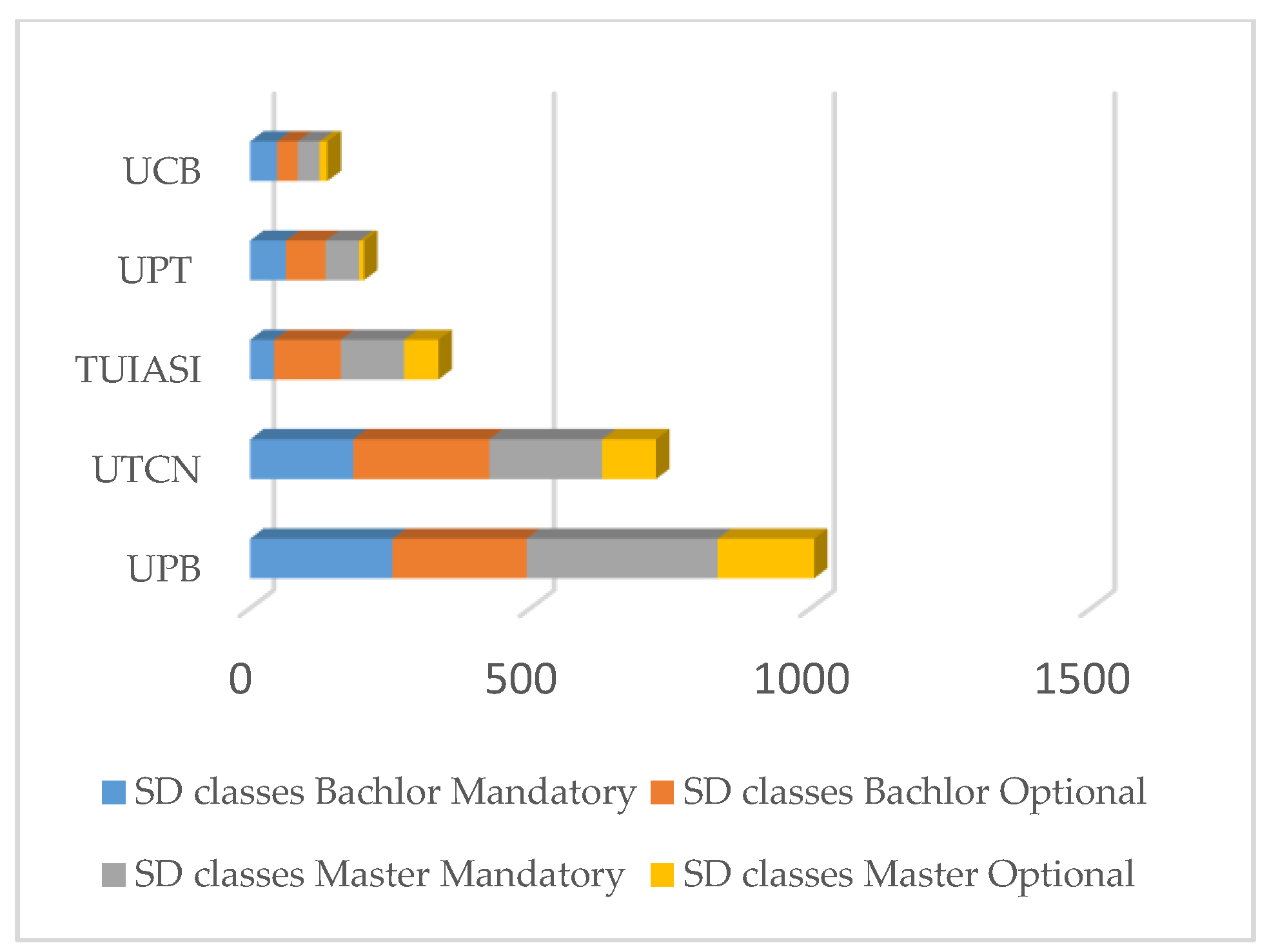
| UPB | UTCB | TUCN | TUIASI | UPT | |
|---|---|---|---|---|---|
| Included/Excluded | Included/Excluded | Included/Excluded | Included/Excluded | Included/Excluded | |
| No. of faculties | 15/0 | 5/2 | 10/2 | 11/0 | 7/3 |
| No. of bachelor programs | 80/2 | 20/0 | 62/0 | 55/3 | 34/0 |
| No. of master programs | 164/0 | 26/0 | 77/0 | 72/9 | 46/0 |
| Biodiversity | Human Rights | Climate Change |
|---|---|---|
| Market economy | Community engagement | Natural resource |
| Corporate citizenship | Natural resources management | Corporate environmental responsibility |
| Corporate responsibility | Pollution management | Corporate responsibility and accountability |
| Poverty prevention | Corporate social responsibility (CSR) | Race relations |
| Culture diversity and intercultural understanding | Recycle | Renewable energy |
| Ecology | Reuse | Ecosystem |
| Rural development | Energy | Sustainability |
| Environmental health and safety | Sustainable development | Environmental stewardship |
| Sustainable growth | Equal opportunity | Sustainable procurement |
| Ethics | Sustainable urbanization | Fair trade |
| Greening | Gender equality | Waste |
| Peace and human security | Risk management | Entrepreneurship |
| Regeneration | Disaster prevention and mitigation | Communication |
| University | Faculty | Bachelor (B) (Total No. Classes/SD Classes) | Master (M) (Total No. Classes/SD Classes) | % SD Class from Total (B/M) |
|---|---|---|---|---|
| UPB | Faculty of Electrical Engineering | 334/11 | 128/13 | 3.29/10.15 |
| Faculty of Power Engineering | 711/95 | 270/84 | 13.36/31.11 | |
| Faculty of Automatic Control and Computer Science | 203/17 | 429/61 | 8.37/14.22 | |
| Faculty of Electronics, Telecommunications and Information Technology | 569/10 | 285/1 | 1.76/0.35 | |
| Faculty of Mechanical Engineering and Mechatronics | 872/30 | 293/49 | 3.44/16.72 | |
| Faculty of Engineering and Management of Technological Systems | 992/22 | 515/73 | 2.22/14.17 | |
| Faculty of Biotechnical Systems Engineering | 256/22 | 129/33 | 8.59/25.58 | |
| Faculty of Transports | 160/2 | 58/4 | 1.25/6.9 | |
| Faculty of Aerospace Engineering | 509/48 | 151/22 | 9.43/14.56 | |
| Faculty of Material Science and Engineering | 492/52 | 166/33 | 10.57/19.88 | |
| Faculty of Applied Chemistry and Materials Science | 631/100 | 283/56 | 15.85/19.79 | |
| Faculty of Engineering in Foreign Languages | 418/35 | 149/32 | 8.37/21.48 | |
| Faculty of Applied Sciences | 159/3 | 80/5 | 1.89/6.25 | |
| Faculty of Medical Engineering | NA | 50/2 | NA/4 | |
| Faculty of Entrepreneurship, Business Engineering and Management | 317/46 | 183/45 | 14.51/24.59 | |
| TOTAL | 9792/1006 | 10.27% | ||
| UTCB | Faculty of Civil, Industrial and Agricultural Constructions | 247/12 | 157/13 | 4.86/8.28 |
| Faculty of Engineering Installations | 258/19 | 91/14 | 7.36/15.38 | |
| Faculty of Hydrotechnics | 329/43 | 108/22 | 13.06/20.37 | |
| Faculty of Railways Roads and Bridges | 80/15 | NA | 18.75/NA | |
| Faculty of Engineering- Foreign Languages | 254/6 | NA | 2.36/NA | |
| TOTAL | 1524/138 | 9.05% | ||
| TUCN | Faculty of Architecture and Urban Planning | 78/6 | 41/4 | 7.69/9.76 |
| Faculty of Automation and Computer Science | 433/29 | 290/2 | 6.7/0.69 | |
| Faculty of Automotive, Mechatronics and Mechanical Engineering | 568/39 | 263/63 | 6.87/23.95 | |
| Faculty of Civil Engineering | 753/58 | 243/31 | 7.7/12.76 | |
| Faculty of Machine Building | 902/48 | 290/52 | 5.32/17.93 | |
| Faculty of Electronics, Telecommunication and Information Technology | 399/21 | 194/16 | 5.26/8.25 | |
| Faculty of Materials and Environmental Engineering | 455/63 | 178/59 | 13.85/33.15 | |
| Faculty of Electrical Engineering | 668/52 | 123/17 | 7.78/13.82 | |
| Faculty of Building Services | 76/5 | 22/5 | 6.58/22.73 | |
| Faculty of Engineering Baia Mare | 960/106 | 188/48 | 11.04/25.53 | |
| TOTAL | 7124/724 | 10.16% | ||
| TUIASI | Faculty of Architecture | 75/1 | 5/1 | 1.33/20 |
| Faculty of Automatic Control and Computer Engineering | 238/12 | 81/15 | 5.04/6.17 | |
| Faculty of Chemical Engineering and Environmental Protection | 753/48 | 124/66 | 6.37/53.23 | |
| Faculty of Civil Engineering and Building Services | 352/8 | 212/26 | 2.27/12.26 | |
| Faculty of Machine Manufacturing and Industrial Management | 552/1 | 190/12 | 0.18/6.32 | |
| Faculty of Electronics, Telecommunications and Information Technology | 252/1 | 113/7 | 0.4/6.19 | |
| Faculty of Electrical Engineering | 526/22 | 75/18 | 4.18/24 | |
| Faculty of Hydrotechnics, Geodesy & Environmental Engineering | 299/41 | 107/20 | 13.71/18.69 | |
| Faculty of Mechanical Engineering | 386/10 | NA | 2.59/NA | |
| Faculty of Material Science and Engineering | 278/6 | 74/7 | 2.16/9.46 | |
| Faculty of Industrial Design and Business Management | 381/12 | 178/12 | 3.15/6.74 | |
| TOTAL | 5251/336 | 6.4% | ||
| UPT | Faculty of Architecture and City Planning | 161/2 | 50/7 | 1.24/14 |
| Faculty of Automation and Computers | 213/16 | 113/10 | 7.51/8.85 | |
| Faculty of Industrial Chemistry and Environmental Engineering | 229/53 | 23/6 | 23.14/26.08 | |
| Faculty of Civil Engineering | 410/35 | 107/15 | 8.54/14.01 | |
| Faculty of Electronics, Telecommunications and Information Technologies | 206/7 | 80/6 | 3.4/7.5 | |
| Faculty of Electrical and Power Engineering | 137/6 | 26/2 | 4.38/7.69 | |
| Faculty of Mechanical Engineering. | 252/16 | 222/22 | 6.36/9.9 | |
| TOTAL | 2229/203 | 9.1% | ||
| UPB | UTCB | TUCN | TUIASI | UPT | ||||||
|---|---|---|---|---|---|---|---|---|---|---|
| SD classes Bachelor | 493 | 85 | 427 | 162 | 135 | |||||
| No. | % | No. | % | No. | % | No. | % | No. | % | |
| • Mandatory | 254 | 51.52 | 48 | 56.47 | 184 | 43.09 | 43 | 26.54 | 64 | 47.41 |
| • Optional | 239 | 48.48 | 37 | 43.53 | 243 | 56.91 | 119 | 73.46 | 71 | 52.59 |
| SD classes Master | 513 | 138 | 297 | 174 | 68 | |||||
| No. | % | No. | % | No. | % | No. | % | No. | % | |
| • Mandatory | 341 | 66.47 | 87 | 63.04 | 201 | 67.68 | 113 | 64.94 | 60 | 88.24 |
| • Optional | 172 | 33.53 | 51 | 36.96 | 96 | 32.32 | 61 | 35.06 | 8 | 11.76 |
| TOTAL | 1006 | 223 | 724 | 336 | 203 | |||||
© 2020 by the authors. Licensee MDPI, Basel, Switzerland. This article is an open access article distributed under the terms and conditions of the Creative Commons Attribution (CC BY) license (http://creativecommons.org/licenses/by/4.0/).
Share and Cite
Alexa, L.; Maier, V.; Șerban, A.; Craciunescu, R. Engineers Changing the World: Education for Sustainability in Romanian Technical Universities—An Empirical Web-Based Content Analysis. Sustainability 2020, 12, 1983. https://doi.org/10.3390/su12051983
Alexa L, Maier V, Șerban A, Craciunescu R. Engineers Changing the World: Education for Sustainability in Romanian Technical Universities—An Empirical Web-Based Content Analysis. Sustainability. 2020; 12(5):1983. https://doi.org/10.3390/su12051983
Chicago/Turabian StyleAlexa, Lidia, Veronica Maier, Anca Șerban, and Razvan Craciunescu. 2020. "Engineers Changing the World: Education for Sustainability in Romanian Technical Universities—An Empirical Web-Based Content Analysis" Sustainability 12, no. 5: 1983. https://doi.org/10.3390/su12051983
APA StyleAlexa, L., Maier, V., Șerban, A., & Craciunescu, R. (2020). Engineers Changing the World: Education for Sustainability in Romanian Technical Universities—An Empirical Web-Based Content Analysis. Sustainability, 12(5), 1983. https://doi.org/10.3390/su12051983






